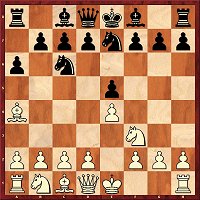| 
| Introductory videos
Let GM Karsten Müller give you an overview of the many offerings on this DVD in his introductory video. From the decisive moments in the top tournaments via selected openings articles (this time two repertoire suggestions for those who play 1.d4: the Slav Accepted with 8.Be2 and an Anti-Volga Gambit with 4.Nf3) and Daniel King's column "Move by Move" all the way to the tactics column hosted by Oliver Reeh and the opening trap with Rainer Knaak. Take a look at it and let the grandmaster from Hamburg set the scene for the DVD. The list of links on the left-hand side gives you direct access to the training columns of your choice. |
 | The major part of Dorian Rogozenco's video retrospective over the tournaments of the last two months is the super-tournament in Wijk aan Zee. In the form of Aronian-Caruana, Carlsen-Aronian und Carlsen-Karjakin he presents three of the best and theoretically most important games of the tournament and explains to you the decisive themes. Rogozenco shows you a strong mating attack against Le Quang Liem by the "heroine of Gibraltar", Women's World Champion Hou Yifan. And the Romanian grandmaster also presents an impressive miniature from the tournament winner of the third top tournament the Aeroflot-Open in Moscow, Mateusz Bartel. |
24.01.-02.02.2012 
Nigel Short
Gibraltar reconquered
| Gibraltar Open 2012 After coming in second last year (behind Ivanchuk) Nigel Short this time ensured an English victory in the tenth Tradewise Chess Festival in Gibraltar. Together with his compatriot Michael Adams he led the field for a long time, but before the final round it was the women's world champion Hou Yifan who was sole leader after a furious series of wins. A victory in the final round brought the English player level with the Chinese player and forced a blitz tiebreak. Thanks to his greater experience Short won the first of two blitz games and went on to secure tournament victory with a draw. |
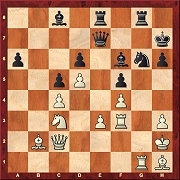
Sasikiran,K - Short,N
Position after 29.Bh1
| In the final round the English player went full out, risks and all, against Krishnan Sasikiran with the Benoni Defence (without the usual ...a6) . Benoni connoisseur Mihail Marin has annotated this game on the DVD and is impressed by Short's handling of the opening and his innovation 10...h6. In the position on the board the Englishman cleverly set some tactical traps. His calculation worked. After 28...Bg7-f6 the Indian GM overlooked a tactical point and with 29.Bh1 deprived his king of the escape square h1. Short's riposte 29...Ne5 fits well into the category of "Protected Squares", to which Maurice Ashley has devoted the first DVD in the series "What Grandmasters don't see". Here too White overlooked the winning tactical blow, because the knight "simply" moves on to a square which is being threatened by an opposing pawn. However, the knight cannot be taken in any case. Because after 30.fxe5 Bxe5+ 31.Rf4 Bxf4 Black will be up by an exchange and a pawn. But after the text move too, 30.Rfg3, the white pawn on c4 falls leaving Black with a winning position. |

Hou Yifan
Outshone everybody
| The surprise of the Chess Festival in Gibraltar was unquestionably Hou Yifan. The women's world champion imposed herself on strong opponents and at the end she not only shared first place but achieved the best Elo performance of all the participants with 2842. Her victims included Le Quang Liem, Alexei Shirov and Judit Polgar. And even in the final round she still had chances in her endgame against Shakhriyar Mamedyarov, but she was not able to take advantage of them. |
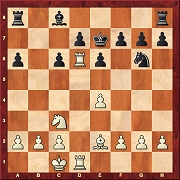
Hou,Y - Polgar,J
Position after 13.Rhd1
| The women's world champion's most significant win was in her duel against Judit Polgar, who, unlike all the other top female players, refuses in principle to take part in tournaments purely for women. It is no wonder that Hou Yifan decided to analyse specifically this game for the DVD. The Hungarian player came up with the rare move 6...Nge7 in the Sicilian Paulsen/Taimanov Variation. As Hou Yifan explains in her comments, she decided to go for a strategic game and to play against the weakness of the d6-square. In the position on the board she had just played 13.Rhd1. There followed 13...Nf4 14.Bf3. But what would have happened now after 14...Nd5? Hou Yifan's goes right into the rook endgame and finishes with the conclusion "equality". But things did not happen like that. Polgar set about things energetically with14...Rb8 followed by g7-g5 and d7-d5 and overstepped the mark with 20...d4. Click on the link under the diagram and play through the game with the analyses of the young women's world champion! |
14.01.-29.01.2012 
Levon Aronian
The world No. 2
| Wijk aan Zee 2012 This year there was not really great excitement in the Tata Steel Tournament in Wijk. The dominance of Levon Aronian was simply too obvious. The Armenian did allow himself a slip-up three rounds before the end against Navara and this gave his pursuers a bit more hope. But a victory over Gelfand and a short draw with Radjabov in the final round made his triumph perfect, a whole point ahead of the field. Aronian got 9 points from 13 games and in doing so notched up no less than seven wins. Carlsen, Radjabov and Caruana shared places two to four with eight points each. On the DVD top players Aronian Carlsen, Caruana, Radjabov and Karjakin annotate their best games for you. |
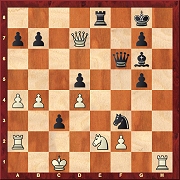
Giri,A - Aronian,L
Position before 41...Ne1
| One of Levon Aronian most spectacular wins was with Black against Anish Giri, who did not manage to carry forward to Wijk the success he had in Reggio Emilia. The tournament victor gives his highly personal comments on this game on the DVD. In a Queen’s Gambit Giri tried out a still relatively new idea (7.Be2); however, his opponent had played an important part in introducing this idea to tournament practice,. So it was no surprise that Aronian was well versed in the position which so rapidly gained in complexity. Just the previous year he had analysed the variation past move 16 and had become convinced that after the positional exchange sacrifice 13...Rxf3 Black not only was not at a disadvantage, but even had the easier game. Giri, on the other hand, did not get to grips with the position and according to Aronian was already losing after 23.Rh1. The Armenian forced the final decision in the position in the diagram with the elegant mating attack 41...Ne1. |

Recent theory
by Mihail Marin
| The games from Wijk aan Zee once more contained a lot of explosive material and new ideas for opening theory. GM Mihail Marin has taken a good look at the material and brought together for you the most interesting theoretical trends in a detailed survey. From the battles in the Berlin Defence and in the scrapes which the Petroff Defence has been getting into via Nakamura’s Dragon Variation and the once more popular French all the way to the Queen’s Gambit Declined (which Aronian successfully defended four times) and the ways of playing the Grünfeld Defence. |

Magnus Carlsen
Not good enough this time
| Magnus Carlsen was the only one who could keep up with Aronian’s tempo for a certain time. In round 3 he even defeated him in their direct encounter (see Karsten Müller’s video analysis in the endgame column), but the Armenian immediately made up the deficit. After eight rounds both players were leading with 5.5 points, but then their paths diverged. Carlsen, who also frequently played for all or nothing in Wijk, lost with White to Karjakin (see Karjakin’s analysis below), and so Aronian was finally able to shake off his companion with a victory over Caruana. |

Carlsen,M - Gashimov,V
Position after 48...Bg1
| For this issue of ChessBase Magazine the leader of the world ranking list has chosen to analyse his encounter with Vugar Gashimov, because this game pleased him even more than his victories over Aronian and Topalov. The game was played in the first round of the tournament and is further proof of the technical abilities of the young Norwegian. Carlsen opened with 1.Nf3 and soon – as he had expected – found himself facing a Hedgehog setup. Carlsen also goes into detail about the opening and refers to Ulf Andersson, whose ideas he had adapted in the game as far as the middlegame. It was in no small measure thanks to two elegant manoeuvres with his king’s knight that Carlsen, after the exchange of queens, clearly got the upper hand. As Carlsen points out in the analysis, in the position on the board he could already have decided the game in his favour with 49.Rc1 Bd4 50.f5 gxf5 51.Bxf5, because after 51...Ne6 52.Ke4 Re2+ 53.Kd5 Black loses a piece. Click on the link under the diagram und and play through this strategic brilliancy with Carlsen’s comments. |

Sergej Karjakin
Fifty-fifty
| Sergey Karjakin had a hard time of it at the start of the tournament. First he was outplayed with White in a Ruy Lopez by Aronian and after that he lost with Black to Caruana. But in Wijk the young Russian demonstrated a willingness to play and a fighting spirit and struck back with two wins. At the end, all in all satisfied, Karjakin was able to look back on a tournament with a lot of ups and downs (only three draws and a score of 50 %). |

Carlsen,M - Karjakin,S
Position after 17...d4
| Even if he was not himself involved in the battle for tournament victory, Karjakin did his bit to bring about the final result with his victory as Black over Carlsen. On the DVD he annotates this particularly spectacular encounter, in which an advanced passed pawn on the d-file pushed forward to become the turning point on which the game hinged. In the position on the board on the left the Black d-pawn has already blossomed into a passed pawn. Here Carlsen’s continuation, 18.Ne4, was too optimistic. Karjakin now exchanged on e4 and continued with the surprising 19...d3. The capture on a8 is now out on account of the tactical finesse 20...d2 21.Bc6 Qd4+ 22.Kh1 dxe1Q 23.Qxe1 Nd3 24.Qf1 Re6 25.Rc2 Nxf4. But also after the text move 20.Rc4 Karjakin first massively increased the pressure down the d-file and at the end liquidated to a won endgame with two extra pawns. |

Fabiano Caruana
In the Top Ten for the first time
| If only... Without his defeat at the hands of Aronian Fabiano Caruana would not only have remained undefeated. He would have definitively been in contention for the first place. But the shared second place and a score of +3 in this field represented another impressive tournament for the 19 year old Italian. In the recent FIDE rankings (as of March 2012) Caruana has climbed up to seventh place! And as his victory in the Open in Reykjavik (which has just ended) shows, he obviously has further to go... |

Caruana,F - Giri,A
Position after 16...f6
| Caruana scored most of his points in the final rounds. After beating Topalov with Black he was highly motivated to push his score further upwards, as he writes at the start of his analysis of the game Caruana-Giri. Against Caruana the young Dutch player chose the Slav with 4...a6 and actually obtained a completely satisfactory position after the strong innovation 10...h5. But Giri did not seem to feel at ease, however, and after the “unnecessary” fixing with 13...h4 there followed the decisive mistake 16...f6. He had obviously overlooked the surprising capture 17.Bxa5, and after 17...Rxa5 18.Nxc6 Ra8 19.Bxb5 White obtained three extremely strong passed pawns on the queenside, whilst Black’s bishop pair was condemned to be mere spectators on the kingside. |

Radjabov,T - Navara,D
Position after 12...Qe6
| Teymour Radjabov remained the only undefeated player in the A-group in Wijk and finished with a shared second place. The Azerbaijani has selected one of his three wins to analyse for you on the DVD. In Radjabov-Navara he chose the Fianchetto setup against the Grünfeld Defence. Navara’s plan of blocking the a8-h1 diagonal after the exchange 5...dxc4 with the manoeuvre Bc8-e6-d5 looked fine at first. But as Radjabov remarks in his analysis, after that it is not easy for Black to find play for his pieces. And in fact, only a short time later the Czech went wrong with 12...Qe6 (diagram). After 13.Ng5 Qg4 14.e4 Qd1 15.Rfxd1 Bxc4 16.Rxc4 Radjabov was "surprised that the endgame was not an immediate win". But it turned back into a real contest until Navara resigned on move 29 as the result of a tactical error. |

Van Wely,L - Giri,A
Position after 23...Rb7
| In round 7 the spectators were treated to a genuine derby with the pairing of Van Wely-Giri. Van Wely, who this year only suffered two defeats in Wijk though he also failed to win a game, annotates the duel between the derby warriors in his own humorous style. The experienced player chose against his young compatriot the Trompowsky, a surprise weapon which in fact seemed to draw blood. The position in the diagram looks anything like promising for Black. Here van Wely played 34.e5 and went on to exchange queens. Perhaps not the best choice, as he admits in his analysis. But even so he was able to increase his advantage one step at a time – until in the endgame with knight against bishop he ran into a counter with which Giri was able to force a draw. Play through the game with van Wely’s comments and let Karsten Müller explain to you Giri’s stroke of genius on video in the endgame column. |
07.02.-15.02.2012 
Mateusz Bartel
wins the ticket
to Dortmund
| Aeroflot Open (Moscow) The Aeroflot Open in Moscow is not only traditionally one of the strongest open tournaments in the world, but there is one special thing in addition: the winner qualifies for the super-tournament which takes place in the summer in Dortmund and can measure up to Kramnik & Co there. In the last two years Le Quang Liem wrote his name on the list of victors. This year the Vietnamese player’s 4 out of 9 could only get him 56th place. Free entry to Dortmund, won against the strongest of competition, went to Mateusz Bartel. The grandmaster from Poland finished in first place on 6.5 out of 9 together with Pavel Eljanov and Anton Korobov, but was declared tournament winner on account of the best tiebreak. Those who did not make it to the top place included Fabiano Caruana, Evgeny Tomashevsky, Evgeny Alekseev and Alexander Khalifman. |

Bartel,M - Caruana,F
Position after 10.cxd5
| The tournament winner has annotated for you two of his wins from Moscow. In his analysis of the game Bartel-Caruana he explains how innovations in opening theory sometimes come about in a curious fashion. In the Slav, the Pole played after 6.h3 Bh5 7.Qb3 Qc7 the innovation 8.Nh4 because he was convinced that he was following one of the most popular variations at the present time. An error, but one that in no way worked to his disadvantage. Perhaps it even contributed to the uncertainty of Caruana, who in the key position on the left is already clearly worse after 10....exd5 according to Bartel’s analysis on account of the misplaced knight on b6. After the opening of the position, Bartel decided the game in his favour after only 21 moves with the capture Bxg6 (see Rogozenco’s video presentation above). |
 | Alexei Shirov: "Botvinnik-Variation is alive again" At the start of this 50 minute video Alexei Shirov takes another look back at the 2011 European team championship (see CBMagazine 146), both at the success of the German team and also at the performance of his Spanish team. Shirov is less than enthusiastic about his own results, though his game with Black against Grischuk in the Botvinnik Variation was a good one. Starting from the analysis of this game, the super-grandmaster develops in this video a a detailed summing up of the latest developments in this sharp variation. He goes into both the systems with 6.a4 (here his recommendation is 6...b5) and also with 6.e4 and shows a series of new themes, on the basis of which the naturalised Spaniard has recovered his belief in this system. |
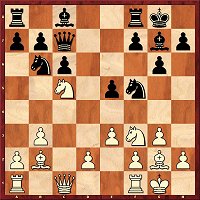
Position after 13...0-0
Daniel King now considers five possible replies, two of which earn all the points available
| From the opening trap to the endgame study Training in ChessBase Magazine begins with the very first moves and takes in all the phases of a game of chess. Above in the links you will find the 13 up-to-date openings articles with their numerous ideas and suggestions for your repertoire. The Opening Trap opening trap by Rainer Knaak (including a Fritztrainer video) this time contains a trap in the Slav (D14). The openings contributions by Leonid Kritz (Albin’s Countergambit) and Andrew Martin (French) have also been produced in video format. These videos, like the Shirov game in the Botvinnik Variation can be found in the column Opening videos. Peter Wells’ subject in his Strategy column is called: "Harmonious positions". In Daniel King’s long-lasting Move by Move it is an Anti-Grünfeld game which is up for discussion (see diagram). And in the tactics (subject: diagonal disasters) and endgame columns (subject: endgames from Wijk aan Zee) Oliver Reeh and Karsten Müller have once more collected for you all that is best in recent tournament practice. |
































